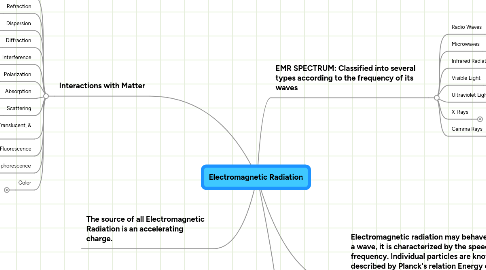
1. Interactions with Matter
1.1. Reflection
1.1.1. The change in direction of a wavefront at an interface between two different media so that the wavefront returns into the medium from which it originated. Examples include the reflection of light, sound, and water waves
1.2. Refraction
1.2.1. The change in the direction of a wave due to a change in its speed. Refraction is described by Snell’s law, which states that the angle of incidence is related to the angle of refraction. For example, when looking through water, the image appears “bent”
1.3. Dispersion
1.3.1. Describes the interrelations of wave properties like wavelength, frequency, velocities, refraction index, etc. The refraction of light in a prism is due to dispersion.
1.4. Diffraction
1.4.1. Occurs when a wave encounters an obstacle. It is the bending of waves around small obstacles, which spread out of waves past small openings. Diffraction occurs with all waves (sound, water, electromagnetic, etc.) and is studied in quantum mechanics, which describes the behavior of energy and matter at the atomic and subatomic scales.
1.5. Interference
1.5.1. The phenomenon that describes two or more waves resulting in a new wave pattern. This is also known as the principle of superposition of waves, which states that the resultant displacement at a point is equal to the vector sum of the displacements of different waves. For example, 2 waves made in a pool will interfere with each other to form a new wave shape.
1.6. Polarization
1.6.1. Is a property of waves that describes oscillations. Electromagnetic waves, gravitational waves, and light waves are affected by gravitational characteristics of the Earth.
1.7. Absorption
1.7.1. The way energy is taken up by matter, mainly the electrons of an atom. Electromagnetic energy is absorbed and transformed into other forms of energy such as heat. Energy is not lost, but transferred. For example, Chloroplasts absorb light and convert it into chemical energy within sugars. The absorbency of an object determines how much of the incident light is absorbed by it. This can help identify a substance.
1.8. Scattering
1.8.1. Some forms of light and sound deviate from a straight trajectory due to the medium through which they pass. This can be predicted by the law of reflection based on the angle of incidence and the normal
1.9. Transparent, Translucent, & Opaque
1.9.1. Transparency allows light to pass through a material while translucency only allows light to pass diffusely. Opacity opposes these properties. If a material is opaque, it does not allow the transmission of light.
1.10. Fluorescence
1.10.1. The emission of light by a substance that absorbed light or electromagnetic radiation. Fluorescent materials emit bright lights when exposed to UV lights.
1.11. Phosphorescence
1.11.1. The process where energy is absorbed by a substance and released slowly in the form of light. This is used for glow in the dark materials which are charged by exposure to light.
1.12. Color
1.12.1. Additive model - Light mixing
1.12.2. Subtractive model - pigment mixing
1.12.3. Physical vs. Physiological light
2. The source of all Electromagnetic Radiation is an accelerating charge.
3. Referenced Wikipedia and College Physics Textbook
4. EMR SPECTRUM: Classified into several types according to the frequency of its waves
4.1. Radio Waves
4.1.1. Wavelengths are longer than infrared light. Made by lightning or artificially-generated radio waves used for fixed and mobile radio communication, navigation, and broadcasting systems
4.2. Microwaves
4.2.1. Electromagnetic waves with wavelengths ranging from one meter to one millimeter, frequencies between 300 MHz and 300 GHz. Used in UHF and EHF based equipment, mainly Global Positioning Systems, radio communications, and microwave ovens.
4.3. Infrared Radiation
4.3.1. Wavelength between 0.7 and 300 micrometers; frequency between 1 and 430 THz. Wavelength is longer than that of visible light. Used extensively for military and civilian purposes such as surveillance, night vision, and homing and tracking. It is also used for weather forecasting and to detect objects such as planets.
4.4. Visible Light
4.4.1. Visible light is the portion of the electromagnetic spectrum that is visible to the human eye. Wavelengths are from 390 to 750 nm; Frequency is 400-790 THz. Computer monitors and televisions mix red, green, and blue color to create colors and images.
4.5. Ultraviolet Light
4.5.1. Wavelength ranges from 10 nm to 400 nm. Ultraviolet light consists of electromagnetic waves with frequencies higher than those that humans identify as the color "violet", so it is named "ultra-violet". Ultraviolet light can cause chemical reactions that can burn human skin in the form of sunburn. There are numerous uses for Ultraviolet light such as fluorescent lamps, air purification, sterilization, food processing, fire detection, sun tanning, etc.
4.6. X-Rays
4.6.1. X-Rays have a wavelength ranging from 10 to 0.01 nanometers; Frequencies ranging from 30 petahertz to 30 exahertz. X-rays are emitted by electrons outside the nucleus. They are generated by an X-ray tube, a vacuum tube that uses a high voltage to accelerate the electrons released by a hot cathode to a high velocity. The high velocity electrons collide with a metal target, creating the X-rays.
4.7. Gamma Rays
4.7.1. Gamma rays have frequencies above 10 x 10^19 Hz and wavelengths less than 10 picometers, which can be smaller than an atom. Gamma rays are a form of ionizing radiation, which can cause damage to living tissue and are known as a health hazard to humans. Gamma rays are used to kill living organisms, such as cancerous cells. The can also penetrate tissue, so they are used for CT Scans. Gamma rays, unlike X-Rays, are emitted from an atomic nucleus.
